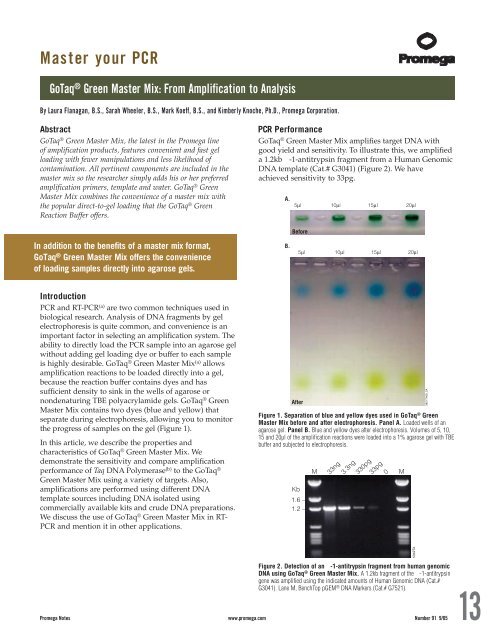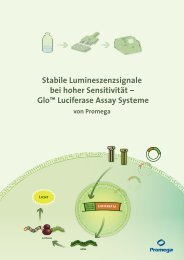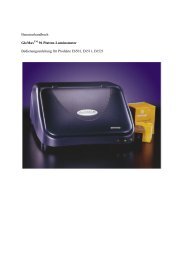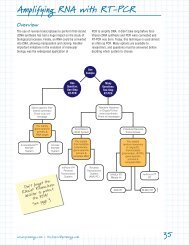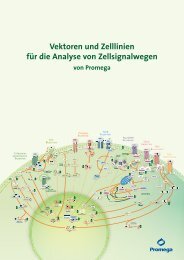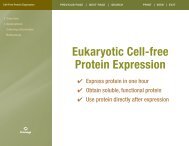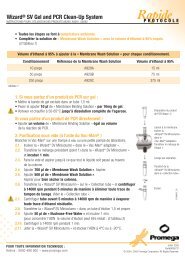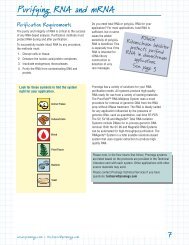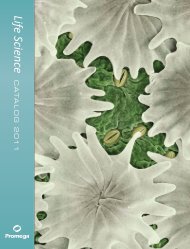Promega Notes 91: GoTaq(R) Green Master Mix: From Amplification ...
Promega Notes 91: GoTaq(R) Green Master Mix: From Amplification ...
Promega Notes 91: GoTaq(R) Green Master Mix: From Amplification ...
Create successful ePaper yourself
Turn your PDF publications into a flip-book with our unique Google optimized e-Paper software.
<strong>Master</strong> your PCR<br />
Article <strong>GoTaq</strong> Subhead<br />
® <strong>Green</strong> <strong>Master</strong> <strong>Mix</strong>: <strong>From</strong> <strong>Amplification</strong> to Analysis<br />
By Laura Flanagan, B.S., Sarah Wheeler, B.S., Mark Koeff, B.S., and Kimberly Knoche, Ph.D., <strong>Promega</strong> Corporation.<br />
Abstract<br />
<strong>GoTaq</strong> ® <strong>Green</strong> <strong>Master</strong> <strong>Mix</strong>, the latest in the <strong>Promega</strong> line<br />
of amplification products, features convenient and fast gel<br />
loading with fewer manipulations and less likelihood of<br />
contamination. All pertinent components are included in the<br />
master mix so the researcher simply adds his or her preferred<br />
amplification primers, template and water. <strong>GoTaq</strong> ® <strong>Green</strong><br />
<strong>Master</strong> <strong>Mix</strong> combines the convenience of a master mix with<br />
the popular direct-to-gel loading that the <strong>GoTaq</strong> ® <strong>Green</strong><br />
Reaction Buffer offers.<br />
In addition to the benefits of a master mix format,<br />
<strong>GoTaq</strong> ® <strong>Green</strong> <strong>Master</strong> <strong>Mix</strong> offers the convenience<br />
of loading samples directly into agarose gels.<br />
Introduction<br />
PCR and RT-PCR (a) are two common techniques used in<br />
biological research. Analysis of DNA fragments by gel<br />
electrophoresis is quite common, and convenience is an<br />
important factor in selecting an amplification system. The<br />
ability to directly load the PCR sample into an agarose gel<br />
without adding gel loading dye or buffer to each sample<br />
is highly desirable. <strong>GoTaq</strong> ® <strong>Green</strong> <strong>Master</strong> <strong>Mix</strong> (a) allows<br />
amplification reactions to be loaded directly into a gel,<br />
because the reaction buffer contains dyes and has<br />
sufficient density to sink in the wells of agarose or<br />
nondenaturing TBE polyacrylamide gels. <strong>GoTaq</strong> ® <strong>Green</strong><br />
<strong>Master</strong> <strong>Mix</strong> contains two dyes (blue and yellow) that<br />
separate during electrophoresis, allowing you to monitor<br />
the progress of samples on the gel (Figure 1).<br />
In this article, we describe the properties and<br />
characteristics of <strong>GoTaq</strong> ® <strong>Green</strong> <strong>Master</strong> <strong>Mix</strong>. We<br />
demonstrate the sensitivity and compare amplification<br />
performance of Taq DNA Polymerase (b) to the <strong>GoTaq</strong> ®<br />
<strong>Green</strong> <strong>Master</strong> <strong>Mix</strong> using a variety of targets. Also,<br />
amplifications are performed using different DNA<br />
template sources including DNA isolated using<br />
commercially available kits and crude DNA preparations.<br />
We discuss the use of <strong>GoTaq</strong> ® <strong>Green</strong> <strong>Master</strong> <strong>Mix</strong> in RT-<br />
PCR and mention it in other applications.<br />
PCR Performance<br />
<strong>GoTaq</strong> ® <strong>Green</strong> <strong>Master</strong> <strong>Mix</strong> amplifies target DNA with<br />
good yield and sensitivity. To illustrate this, we amplified<br />
a 1.2kb -1-antitrypsin fragment from a Human Genomic<br />
DNA template (Cat.# G3041) (Figure 2). We have<br />
achieved sensitivity to 33pg.<br />
5µl 10µl 15µl 20µl<br />
5µl 10µl 15µl 20µl<br />
Figure 2. Detection of an -1-antitrypsin fragment from human genomic<br />
DNA using <strong>GoTaq</strong><br />
13<br />
<strong>Promega</strong> <strong>Notes</strong> www.promega.com Number <strong>91</strong> 9/05 ® <strong>Green</strong> <strong>Master</strong> <strong>Mix</strong>. A 1.2kb fragment of the -1-antitrypsin<br />
gene was amplified using the indicated amounts of Human Genomic DNA (Cat.#<br />
G3041). Lane M, BenchTop pGEM ® DNA Markers (Cat.# G7521).<br />
A.<br />
B.<br />
Before<br />
After<br />
Figure 1. Separation of blue and yellow dyes used in <strong>GoTaq</strong> ® <strong>Green</strong><br />
<strong>Master</strong> <strong>Mix</strong> before and after electrophoresis. Panel A. Loaded wells of an<br />
agarose gel. Panel B. Blue and yellow dyes after electrophoresis. Volumes of 5, 10,<br />
15 and 20µl of the amplification reactions were loaded into a 1% agarose gel with TBE<br />
buffer and subjected to electrophoresis.<br />
Kb<br />
1.6 –<br />
1.2 –<br />
M 33ng<br />
3.3ng<br />
330pg<br />
33pg<br />
0<br />
M<br />
5342TA<br />
3821TA08_2A
<strong>GoTaq</strong> ® <strong>Green</strong> <strong>Master</strong> <strong>Mix</strong>... continued<br />
The <strong>GoTaq</strong> ® <strong>Green</strong> <strong>Master</strong> <strong>Mix</strong> performance was similar<br />
to or better than standard Taq DNA Polymerase in the<br />
amplification reactions described here. We compared the<br />
ability of the two enzymes to amplify seven DNA targets.<br />
For the <strong>GoTaq</strong> ® <strong>Green</strong> <strong>Master</strong> <strong>Mix</strong> amplifications, the<br />
provided buffer contained MgCl 2 (1.5mM final<br />
concentration) and dNTPs (200µM each, final<br />
concentration). For Taq DNA Polymerase, the buffer<br />
provided with the enzyme was used, and MgCl 2 and<br />
360bp<br />
1.1kb<br />
1.3kb<br />
1.8kb<br />
2.4kb<br />
3.1kb<br />
3.9kb<br />
M T G T G T G T G T G T G T G M<br />
Figure 3. Comparison of amplification reactions using <strong>GoTaq</strong> ® <strong>Green</strong><br />
<strong>Master</strong> <strong>Mix</strong> and Taq DNA Polymerase. The following fragments were amplified<br />
using standard Taq DNA Polymerase (Lanes T) or <strong>GoTaq</strong> ® <strong>Green</strong> <strong>Master</strong> <strong>Mix</strong> (Cat.#<br />
M7122; Lanes G). A 360bp -1-antitrypsin fragment from 3.3ng Human Genomic<br />
DNA (Cat.# G3041); 1.1kb IL-1 fragment from 10ng Mouse Genomic DNA; 1.3kb<br />
-globin fragment from 330pg Human Genomic DNA; 1.8kb APC fragment from 3.3ng<br />
Human Genomic DNA; 2.4kb APC fragment from 3.3ng Human Genomic DNA; 3.1kb<br />
APC fragment from 3.3ng Human Genomic DNA; 3.9kb APC fragment from 3.3ng<br />
Human Genomic DNA. Lane M, BenchTop 1kb DNA Ladder (Cat.# G7541).<br />
A. Mouse Toe Preparations<br />
bp<br />
676 –<br />
517 –<br />
C. Corn DNA<br />
bp<br />
300 –<br />
150 –<br />
M<br />
M 25ng<br />
5345TA<br />
4µl crude mouse<br />
toe preparations<br />
0<br />
2.5ng<br />
250pg<br />
25pg<br />
0<br />
M<br />
M<br />
dNTPs were added to final concentrations equal to those<br />
found in the <strong>GoTaq</strong> ® <strong>Green</strong> <strong>Master</strong> <strong>Mix</strong>. We obtained<br />
better yield for a number of targets using the <strong>GoTaq</strong> ®<br />
<strong>Green</strong> <strong>Master</strong> <strong>Mix</strong> when compared to standard Taq DNA<br />
Polymerase (Figure 3). In addition, we saw increased<br />
sensitivity with these targets (data not shown). We<br />
successfully amplified targets from 143bp to 4.1kb (data<br />
not shown) from a genomic DNA template using <strong>GoTaq</strong> ®<br />
<strong>Green</strong> <strong>Master</strong> <strong>Mix</strong> (Table 1).<br />
Different Template DNA Sources<br />
Researchers frequently amplify template DNA isolated<br />
using crude DNA preparations or commercially available<br />
kits. We demonstrate the ability of <strong>GoTaq</strong> ® <strong>Green</strong> <strong>Master</strong><br />
<strong>Mix</strong> to amplify template DNA from both crude<br />
preparations and commercially available systems (Figure<br />
4). <strong>GoTaq</strong> ® <strong>Green</strong> <strong>Master</strong> <strong>Mix</strong> amplified crude DNA<br />
templates including genomic mouse toe DNA (1) (Figure<br />
4, Panel A) and bacterial colony DNA from bacteria<br />
harboring a T-vector plasmid (pTARGET Mammalian<br />
Expression Vector, Cat.# A1410) containing an insert<br />
(Figure 4, Panel D). The <strong>Master</strong> <strong>Mix</strong> also amplified DNA<br />
templates isolated using commercially available systems<br />
including human DNA isolated from blood using the<br />
MagneSil ® Genomic, Large Volume System (Cat.# A4080)<br />
(Figure 4, Panel B) and corn DNA isolated using Wizard ®<br />
Magnetic 96 DNA Plant System (Cat.# FF3760) (Figure 4,<br />
Panel C).<br />
B. DNA from Blood<br />
M 33ng<br />
D. Bacterial Lysates<br />
5µl crude<br />
bacterial lysates<br />
M<br />
3.3ng<br />
330pg<br />
33pg<br />
0<br />
Figure 4. <strong>Amplification</strong> of DNA from different sources using <strong>GoTaq</strong><br />
14<br />
® <strong>Green</strong> <strong>Master</strong> <strong>Mix</strong>. Panel A. <strong>Amplification</strong> of a 670bp MIN (multiple intestinal neoplasia) fragment<br />
from crude mouse toe DNA preparations (1,2). Four microliters of DNA from four different crude mouse toe preparations was added to PCR amplifications. Lane 0, no-template<br />
control. Lane M, Bench Top pGEM ® DNA Markers (Cat.# G7521). Panel B. <strong>Amplification</strong> of a 2.4kb APC fragment of human genomic DNA from blood purified using the<br />
MagneSil ® Genomic, Large Volume System (Cat.# A4080). The indicated amount of DNA was amplified using <strong>GoTaq</strong> ® <strong>Green</strong> <strong>Master</strong> <strong>Mix</strong>. Lane M, BenchTop pGEM ® DNA Markers<br />
(Cat.# G7521). Panel C. <strong>Amplification</strong> of a 143bp EST AWO67275 fragment from corn DNA isolated using Wizard ® Magnetic 96 DNA Plant System (Cat.# FF3760). The DNA was<br />
amplified using <strong>GoTaq</strong> ® <strong>Green</strong> <strong>Master</strong> <strong>Mix</strong> using the indicated amounts of corn DNA as a template (3). Lane M, BenchTop PCR Markers (Cat.# G7531). Panel D. <strong>Amplification</strong> of a<br />
542bp plasmid insert fragment from crude bacterial colony DNA preparations. Bacterial colonies were suspended in 50µl of sterile water, boiled for 10 minutes, centrifuged for 5<br />
minutes, and 30µl of the supernatant was removed. The supernatant was diluted 1:10,000, and 5µl of the diluted crude bacterial DNA from 3 colonies was amplified. Lane 0,<br />
no-template control. Lane M, BenchTop PCR Markers (Cat.# G7531).<br />
kb<br />
2.6 –<br />
1.6 –<br />
bp<br />
750 –<br />
500 –<br />
300 –<br />
0<br />
M<br />
M<br />
5343TA
Table 1. Compatibility of <strong>GoTaq</strong> ® <strong>Green</strong> <strong>Master</strong> <strong>Mix</strong> with Various<br />
Applications.<br />
Application <strong>GoTaq</strong> ® <strong>Green</strong> <strong>Master</strong> <strong>Mix</strong><br />
PCR<br />
Amplify targets from 143bp to 4.1kb in length Yes<br />
PCR Enhancer<br />
DMSO (5%) Yes<br />
Betaine (1M) Yes<br />
Uncoupled RT-PCR<br />
Amplify fragment from cDNA generated by the<br />
ImProm-II Reverse Transcription System Yes<br />
Amplify fragment from cDNA generated by<br />
the Reverse Transcription System (AMV RT) Yes<br />
Direct Gel Loading<br />
Agarose or nondenaturing TBE polyacrylamide gel Yes<br />
Cloning<br />
Compatible with T-vector cloning Yes<br />
The <strong>GoTaq</strong> ® <strong>Green</strong> <strong>Master</strong> <strong>Mix</strong> gave good yield and<br />
sensitivity in these amplifications. The use of <strong>GoTaq</strong> ®<br />
<strong>Green</strong> <strong>Master</strong> <strong>Mix</strong> can streamline commonly used<br />
techniques such as PCR screening methods to determine<br />
the genotype of organisms from crude DNA preparations<br />
and purified DNA from plants, bacteria and animals.<br />
Use in RT-PCR<br />
When doing uncoupled RT-PCR, the cDNA is generated<br />
by the reverse transcriptase, then all or part of this<br />
reaction is used for PCR. The technical literature for our<br />
two popular reverse transcription systems, (ImProm-II<br />
Reverse Transcription System (c,d) (Cat.# A3800) and the<br />
Reverse Transcription System (c) (Cat.# A3500), give<br />
protocols for using stand-alone enzymes for PCR.<br />
However, <strong>GoTaq</strong> ® <strong>Green</strong> <strong>Master</strong> <strong>Mix</strong> can be used for<br />
PCR after generation of cDNA in uncoupled RT-PCR. We<br />
tested this by generating cDNA from total mouse liver<br />
RNA using the ImProm-II Reverse Transcription<br />
System (4) (Cat.# A3800) and then amplifying a 540bp,<br />
-actin target using <strong>GoTaq</strong> ® <strong>Green</strong> <strong>Master</strong> <strong>Mix</strong>. We used<br />
1µl of the reverse transcription reaction for the data<br />
generated in Figure 5, and we achieved sensitivity to 5pg.<br />
bp<br />
600 –<br />
500 –<br />
400 –<br />
In additional experiments we amplified the 540bp -actin<br />
fragment using a 20µl ImProm-II Reverse Transcription<br />
reaction in 100µl amplifications (data not shown). We<br />
found that we could use either 40µl or 50µl <strong>GoTaq</strong> ®<br />
<strong>Green</strong> <strong>Master</strong> <strong>Mix</strong> in the 100µl amplifications with equal<br />
yield and sensitivity. However, for some targets there<br />
may be critical, specific conditions that might be<br />
sensitive to carryover of reaction components (e.g.,<br />
MgCl 2 ) from the reverse transcription reactions. In these<br />
cases we recommend the use of <strong>GoTaq</strong> ® Flexi DNA<br />
Polymerase (Cat.# M82<strong>91</strong>). In addition we found that<br />
<strong>GoTaq</strong> ® <strong>Green</strong> <strong>Master</strong> <strong>Mix</strong> can also be used for PCR after<br />
generation of cDNA by the Reverse Transcription System<br />
(Cat.#A3500; Table 1, data not shown).<br />
Additional Applications<br />
Some targets are difficult to amplify due to secondary<br />
structure or high GC content. Frequently, the addition<br />
of PCR-enhancing agents such as dimethyl sulfoxide<br />
(DMSO) or betaine enable successful amplification (5–8).<br />
We performed amplifications containing DMSO or<br />
betaine and found that both are compatible with <strong>GoTaq</strong> ®<br />
<strong>Green</strong> <strong>Master</strong> <strong>Mix</strong> (Table 1, specific data not shown). In<br />
addition, neither enhancing agent had an adverse effect<br />
on the blue or yellow dyes. Both dyes retained their color<br />
and migrated as expected in agarose gels.<br />
Fragments generated using <strong>GoTaq</strong> ® <strong>Green</strong> <strong>Master</strong> <strong>Mix</strong><br />
can be cloned into T-vectors (Table 1, data not shown).<br />
This indicates that <strong>GoTaq</strong> ® DNA Polymerase, like<br />
standard Taq DNA Polymerase, adds a single<br />
deoxyadenosine in a template-independent manner<br />
to the 3´ end of amplified fragments (9,10).<br />
<strong>Promega</strong> <strong>Notes</strong> www.promega.com Number <strong>91</strong> 9/05 15<br />
M<br />
50ng<br />
5ng<br />
500pg<br />
50pg<br />
5pg<br />
Figure 5. Detection of a -actin fragment from total mouse liver RNA.<br />
Twenty-microliter cDNA synthesis reactions were performed using the indicated<br />
amounts of total RNA from mouse liver isolated using RNAgents ® Total RNA Isolation<br />
System (Cat.# Z5110). The cDNA was synthesized as directed in the ImProm-II Reverse<br />
Transcription System Technical Manual (4) using the Oligo(dT) 15 Primer (Cat.#<br />
C1101). A 540bp -actin fragment was amplified using 1µl of the cDNA synthesis<br />
reactions and 50µl of <strong>GoTaq</strong> ® <strong>Green</strong> <strong>Master</strong> <strong>Mix</strong> in 100µl PCR amplifications. Lane M,<br />
100bp DNA Ladder (Cat.# G82<strong>91</strong>).<br />
0<br />
M<br />
5344TA
16<br />
<strong>GoTaq</strong> ® <strong>Green</strong> <strong>Master</strong> <strong>Mix</strong>... continued<br />
Direct Gel Loading<br />
<strong>GoTaq</strong> ® <strong>Green</strong> <strong>Master</strong> <strong>Mix</strong> eliminates the need to add<br />
loading buffers and dyes to amplification samples prior<br />
to electrophoresis. The 1X <strong>Master</strong> <strong>Mix</strong> has sufficient<br />
density to sink into the wells of a gel, and migration<br />
can be monitored using the two dyes (Figure 1, Panel B).<br />
During electrophoresis, the blue dye migrates at the same<br />
rate as a 3–5kb DNA fragment in a 1% agarose gel<br />
(approximately the same rate as the commonly used<br />
loading dye, xylene cyanol). The yellow dye migrates<br />
at a rate faster than the primers used in the amplification<br />
reactions (


